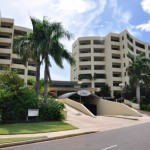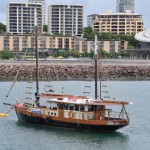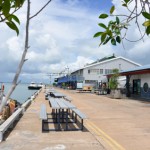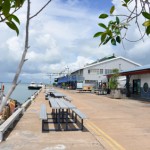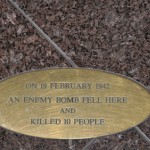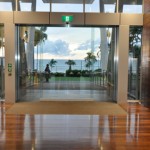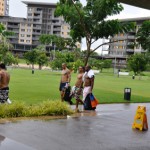Darwin, a colourful chameleon city.
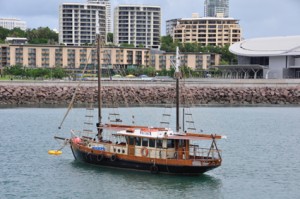
A Chinese junk in Darwin harbour contrasts with the contemporary skyline
I was whisked away from the Darwin railway station in a shiny, red Robinson R44 Raven II helicopter. And I felt very star-like as the helicopter swooped over Darwin’s exciting new Wharf precinct, and the wreckage of the historic bombed wharf, so dramatically portrayed in “Australia’’. Old jetty pylons jut this way and that out of the sea as a dramatic reminder of Japan’s bombing raids on Darwin in February 1942. Few people know that air raid on the morning of the 19th was one of the biggest and deadliest air attacks yet seen in World War II, by the same Japanese air commander and bombing crew who bombed Pearl Harbour. There were big differences though. More bombs fell on Darwin, more citizens were killed – and more ships were sunk.
I had read of Australia’s only mainland assault by an enemy force in the book An Awkward Truth by Peter Gross, and I already knew these facts and that the raid caused the worst death toll from any event on Australian soil. Yet, it was quite different to see dramatic reality of the bombed wharf than read about it. Below me, too, lay Darwin of today. It’s striking cityscape, its long shoreline and the vast town harbour and behind it all, lush mangrove swamps. It was so exhilarating it scotched my long held fear of helicopter flight. All too soon, we plopped ever-so-gently on the grassy helipad at Skycity Hotel, outfitted with enough opulence to win a Qantas Australian Tourism Award in 2009.
It was monsoon season and the city was a revelation with its colourful, office architecture, posh marina housing, restaurant strips and, most exciting of all, the new Wharf Precinct jammed with exotic apartment blocks.
Darwin is something of a chameleon town, having reinvented itself, following more than its share of hardship over the years. Not only has it risen phoenix-like from the devastation of its wartime bombing, but also following Cyclone Tracy in 1974. And its tourism growth is linked to an Australia growing awareness that war really came to Australia in Darwin. The Japanese pilots bombed three hospitals, flattened the police barracks, destroyed the post office and communications centre (remember that footage in Australia) and wrecked Government House.
The bombings left the harbour and airfields ruined and in flames after those two raids that first day and there were 62 others. Which is why we stop at the site of the bombed Post Office so emotively captured in “Australia’’. There was no escape for the staff who had fled to a bunker, where they died in a direct bomb hit. We read in silence those names of the first victims of bombing on mainland Australia. We look at the only one fieldstone wall of the original Post Office left standing, pock-marked with machinegun fire but preserved within the government building complex.
We drove to the Esplanade and walked over to the war memorial which overlooks the harbour, before driving on to Stokes Hill Wharf, where the set for the movie “Australia” was built. Darwin’s wharf is the popular leisure hub on weekends and high tourist seasons and this is where passengers of cruise ships alight. Darwin Museum at Bullocky Point holds the story of Cyclone Tracy, which destroyed Darwin early on December 25, 1974 – Christmas Day, killing 65 people. It was a sobering walk around the museum display where the story is told graphically with television footage and radio commentary from journalists, who lived here. A photographic display captures the terror of how Darwin was flattened.
Yet, Darwin transformed itself for a second time in our lifetime from destruction into such an exciting multicultural place, bursting with growth and change. No other capital city has suffered such huge civilian losses in an act of war or through an act of nature. (The bushfires hit regional communities.) The Darwin of today is a vibrant city, the result of contemporary urban planning, dynamic architecture and beautiful open parks and modern housing.
Monsoonal rains sheet down on our second night at the contemporary Vibes Hotel. The weather continues its fury during breakfast where we watch, amused as the Cairns Rugby Team, the hunky Cowboys, huddle under the veranda in their budgie smugglers waiting for the storm to pass. They were on their way to swim in the new wave pool, the tourist highlight of the wharf precinct, when the deluge struck. On our last morning, we visit Darwin’s newest attraction, Crocosaurus Cove, with its countless crocodiles of all sizes.
Darwin, with its unique war history is unlike anywhere else in Australia. It’s a trendy, multicultural, tropical city and its colourful population mix (50 language groups in 100,000). It appears to be the most Asian of our capital cities and it also boasts a high percentage of traditional landowners, the Larrakia Aboriginal people. Monsoonal weather adds an exciting element and low tourist season offers reduced hotel rates and a luxury holiday on a budget in a beautiful place.
More information on www.tourismnt.com.au.
- Darwin suburbia – a tropical city
- The stunning architecture of the apartment block where Nicole Kidman stayed.
- A Chinese junk in Darwin harbour contrasts with the contemporary skyline
- Darwin’s wharf, where coastguards and ocean liiners alike dock.
- Tourists in Darwin come face to face with Australia’s WWII mainland airstrikes
- The classy, contemporary seasideentrance to Skycity, Darwin
- Darwin’s exciting new Waterfront precinct ringed with apartments.
RSS feed for comments on this post. TrackBack URI

